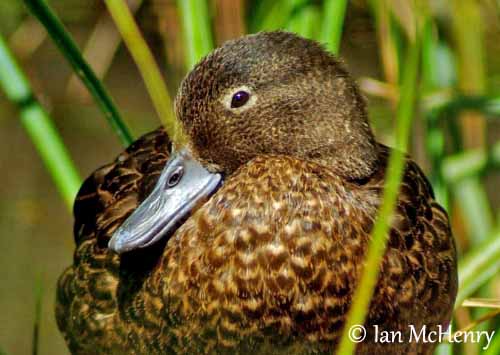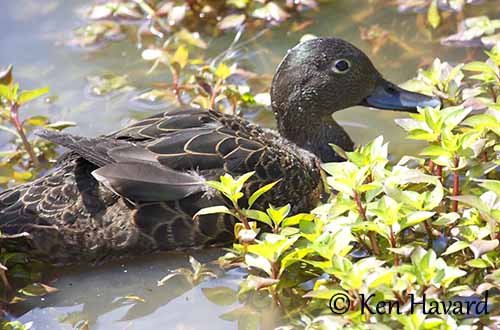
Fr: Sarcelle de Nouvelle Zélande
All: Aucklandente
Esp: Cerceta de la Ila Auckland y Castaña
Ita: Anatra della Nuova Zelanda
Nd: Bruine Taling
Sd: Brun kricka
Photographers:
Ken Havard
My Bird Gallery & Flickr gallery 1 & Flickr gallery 2
Ian McHenry
My New Zealand Birds
Texte de Nicole Bouglouan
Sources:
HANDBOOK OF THE BIRDS OF THE WORLD vol 1 by Josep del Hoyo-Andrew Elliot-Jordi Sargatal - Lynx Edicions - ISBN: 8487334105
GUIDE DES CANARDS, DES OIES ET DES CYGNES – de Steve Madge - Delachaux et Niestlé - ISBN: 2603013769
BirdLife International (BirdLife International)
New Zealand birds and birding (Narena Olliver)
Tiritiri Matangi Open Sanctuary
New Zealand Teal or Brown Teal
Anas chlorotis
Anseriformes Order – Anatidae Family
INTRODUCTION:
The New Zealand Teal is endemic to New Zealand. After more widespread on these islands, this species is living today in restricted range on small islands and in bays. The reintroduction of captive-reared young birds has led to the establishment of a resident breeding population, and smaller populations occur on the adjacent islands. Increasing numbers need to be more stable, after large declines due to introduced predators.
The New Zealand Teal is the only teal able to fly, unlike the Auckland Teal and the Campbell Teal which only walk and run. However, the Grey Teal (Anas gracilis) can fly.

PROTECTION / THREATS / STATUS:
The New Zealand Teal has restricted range. The population size is estimated as 1,300 mature individuals, and has been increasing since several years, thanks to intensive management.
Like numerous island birds, the main threats are the introduced predators, the degradation of the habitat for agriculture and human developments, drainage of wetlands and illegal hunting.
Reintroduction of captive birds in order to maintain a viable breeding population, protection of the birds along roads, restoration of some parts of the habitat and intensive predator control are continuing, in order to maintain and increase the populations.
Currently, the New Zealand Teal is classified as Endangered.
RANGE:
The New Zealand Teal is found in the isolated areas of North Island ((Northland, Great Barrier Island and Coromandel Peninsula), and this species has been reintroduced to Kapiti and Mana Islands and the Zealandia Sanctuary in Wellington in the Cook Strait. It was formerly more widespread on North, South, Chatham and Stewart Islands, New Zealand.
HABITAT:
The New Zealand Teal has now restricted habitat mainly in agricultural areas. It frequents ponds for breeding and feeding, and can be seen along small streams with some hanging vegetation. However, the estuaries of Great Barrier Island provide them some good feeding areas.
This species was formerly common in forest swamps and other habitat types such as estuaries, tidal flats, beaches, rivers, mountain lakes, pasture and forest. The changes in the habitat with wetland drainage and human developments in estuaries have led the teals to the small islands and restricted areas where they are living today.
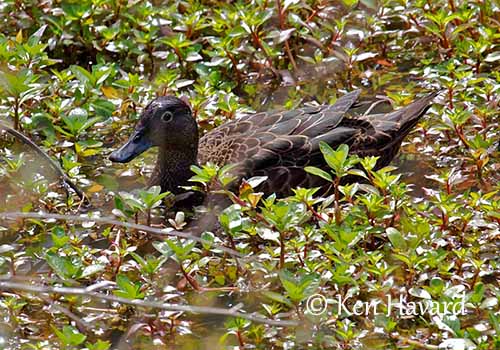
Outside the breeding season, they are fairly gregarious and gather at roost sites in small groups.
The New Zealand Teal is monogamous, and the pair strongly defends the territory. Some pairs occupy exclusive territories year round, in locations where the food is abundant and with dense vegetal cover for nesting. Other pairs leave their territories seasonally, and return when the water levels are better for feeding.
The pairs are widely dispersed and breed as single pairs.
The New Zealand Teal does not migrate. It can fly, but it is rarely seen in the air. However, some birds and especially males may leave the island and migrate to the nearby estuaries during winter. They are more vulnerable to predators when they are away from their territories.
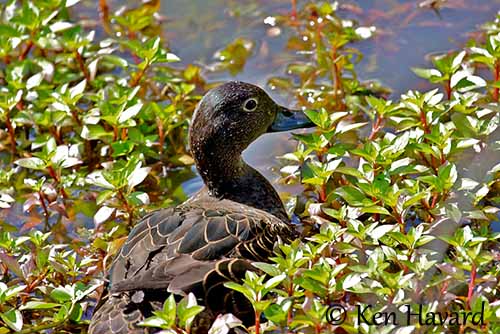
DESCRIPTION OF THE BIRD:
Biometrics:
Length: 48 cm
Weight: M: 620-700 g – F: 530-600 g
The adult male in breeding plumage shows green iridescence on head and sometimes a narrow white neck collar. The plumage is warm brown overall with pale-edged feathers on the upperparts. The breast is mostly chestnut, and we can see the white flank patch at tail’s base.
In non-breeding plumage, male, female and juvenile are similar in plumage but the male is larger.
The bill is bluish-black. The brown eyes are surrounded by white eyering. Legs and webbed feet are dark grey.
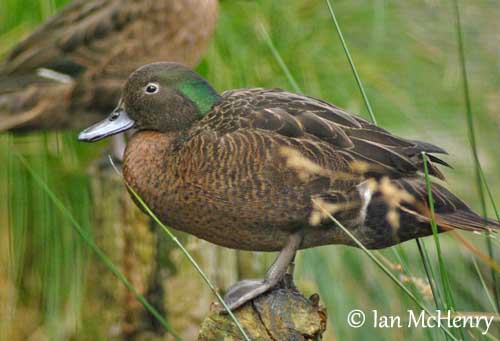
CALLS AND SONGS: SOUNDS BY XENO-CANTO
The New Zealand Teal male and female have different calls. The male gives soft, high-pitched, wheezy whistles and short, dry calls, whereas the female gives rasping growls and rapid quack.
BEHAVIOUR IN THE WILD:
The New Zealand Teal feeds on terrestrial, marine and freshwater invertebrates such as insects and larvae, beetles, caterpillars, moths and earthworms. It also takes marine food including gastropods and bivalves, crustaceans and worms, found in soft sediments in inter-tidal areas. It also consumes plant matter such as seeds, fruit, fungi, foliage and aquatic vegetation.
It feeds usually at dusk and at night by probing, dabbling and upending, both in freshwater and marine waters. However, it may feed by day too in estuaries, according to the tides. They are more active at low tide.
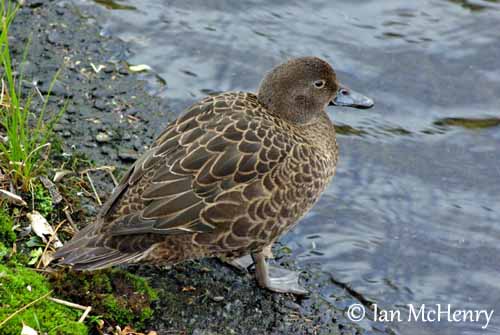
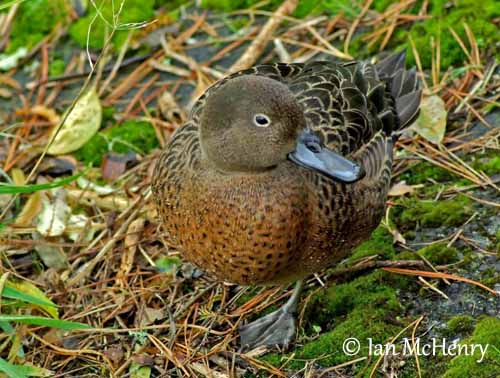
REPRODUCTION OF THIS SPECIES:
The breeding season occurs mainly between July and September, but they can breed in most months except late autumn.
The nest is usually protected by vegetation. It is often placed in dry areas, deep at base of rushes, grass or fern clumps and near water.
The female lays 5-6 pale yellowish eggs, and incubates during 27-30 days. Both parents accompany the young birds until they fledge, about 55 days after hatching. They often remain in family groups until the nest breeding season.
